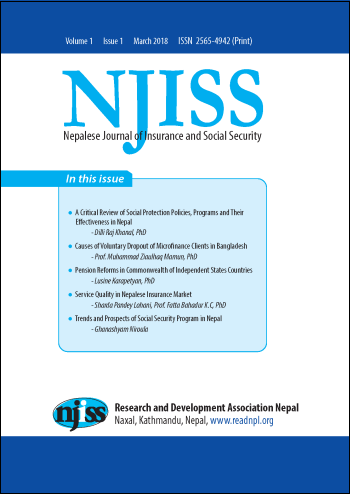Trends and Prospects of Social Security Program in Nepal
Keywords:
Social Security, Vital Events, Old Citizens, Indigenous Group, Social Security AllowancesAbstract
The objective of the paper is to examine the current status, trend and growth of the social security program over the years in Nepal. The secondary data for four years has been used and data were obtained from the websites of the Ministry of Federal Affairs and Local Development. There are ten different categories of beneficiaries viz. senior citizens, senior Dalits, widow, single women, endangered indigenous nationalities, Dalit children, Karnali zone children, severe affected disable, fully disable, Karnali zone senior citizens who are receiving allowances as social security benefits.
The study concludes that during the study period, all allowances except treatment for senior citizens (70 years and above) increased by 100 percent. The rate of allowances was lowest for children (Karnali and Dalit) and highest rate for fully disabled, Endangered Indigenous/Nationalities. It is seen that the government is more concerned towards the health of the senior citizens 70 years and above. The number of beneficiaries viz. senior citizens all (Dalits, Karnali and others), disable (Fully and severly affected), Endangered ethnic group is in increasing trend while Single/widow and Children (Dalit and Karnali) have been found in decreasing trend. Out of five clusters, the number of elder citizens is highest followed by single widow and children of Dalit and Karnali zone. Disable (Fully and severly affected) and Endangered ethnic group are only 4 percent of total beneficiaries in 2015/16. The growth of the total beneficiaries is less than 1 percent during three year period but number of disabled increased by 95% while widow/single women decreased by 10 percent in three years. Throughout the last three fiscal years, the largest number of beneficiaries were senior citizens followed by Single women/widow and children.
Downloads
Downloads
Published
How to Cite
Issue
Section
License
Copyright © Nepal Insurance and Risk Management Association

The articles in NJISS are licensed under a Creative Commons Attribution-NonCommercial 4.0 International License. This CC BY-NC license allows reusers to distribute, remix, adapt, and build upon the material in any medium or format for noncommercial purposes only, and only so long as attribution is given to the creator.
It includes the following elements:
BY - Credit must be given to the creator (authors)
NC - Only noncommercial uses of the work are permitted.

